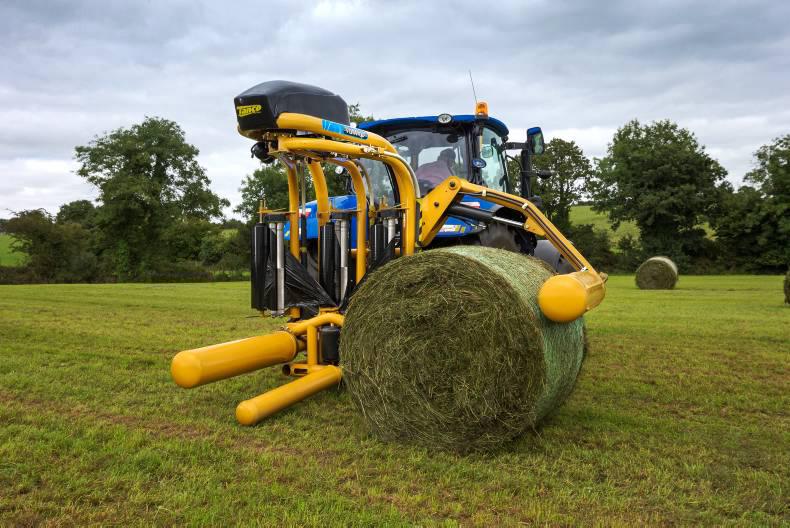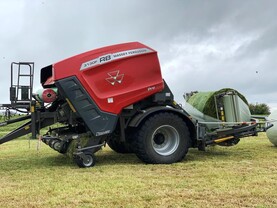Bale-wrapping was first seen in Ireland in 1981. At that time, the bales were made and placed in a big bag and tied. The system never really took off as labour and damage to bags were the incumbents to success.
It was not until the blue Silawrap wrappers arrived from Australia in 1986 that baled silage started to become popular in Ireland.
The Integrated Packaging (IP) Company had succeeded in mechanising the process.
Our focus supplement this week looks at the making and quality-testing of the Silawrap brand made in the former IP factory in Gorey. This Focus supplement also looks at something we all know about handling bales – the weight on the front axle of the loader or tractor.
Bruce Lett went to Teagasc Oakpark in Carlow to learn more about this.
The supplement will cover baler maintenance, with a report on the progress of the transparent Coveris Crystal film.
Norman Igor from Kildare gives his views on why he prefers a wrap-and-stack system for handling bales.
In the main paper, the machinery pages also have news from Claas and John Deere on their developments in grass machinery.
There have been some reports of heavy cover paddocks mowed and wrapped already – not too many we would expect, as grass growth is only reaching its full potential now. The baled silage season is much longer than it used to be.
Grassland management, ensuring leafy, young grass with higher protein, has seen the need for undergrazed paddocks and fields to be mowed and baled.
The flexibility of baled silage allows this to happen easily. Talking to a number of farmers and contractors, flexibility is a word that arises a lot in conversation.
The onus on quality forage is, and must be, a key driver for any grass-based system. A low-cost grass system will not work well with low-quality grass. It would be like a low-cost airline running low-quality planes – not a good combination.
While compiling this supplement, I spoke to a number of people in the plastic film business, and the common message from them was that quality grass needs to be put in the bales to get the full potential value of the ensiled grass. This always starts with management of the sward, reseeding old leys, using a grass mixture suitable for baled silage and optimum fertilisation of the grass crop.
Grass is a crop that responds well in this country to good management and the rewards can be reaped in the bale at the end of the season. It costs the same to mow, bale, wrap and store good bales as it does bad bales.
A simple method of establishing the dry matter content is to take a handful of grass and squeeze it (Table 1).
Looking into this further, with help from a Teagasc online calculator, I compared the value of silage relative to a tonne of rolled barley priced at €191/t.
According to the calculations on the feed value, that may be out by 10% for wet forage such as silage, accounting for ensiling loses and contamination.
In Table 2, the potential value of Bale 1, which costs the same money to make as Bale 2, will deliver much higher results in liveweight gain and milk yield.
The benefits of increasing the dry matter percentage are evident, as less water and more of the potential feed value are ensiled.
If a farmer has 1,000 bales for the year and the feed value and quality is good, there is potential to save on concentrate feed bills on the farm and optimise the grass-based system.
Bales at 35% to 40% dry matter can be more susceptible to mould growth and most suppliers of silage wrap film would recommend using at the very least six layers of film to prevent air entering the bale.
The next issue is that the size and weight of bales has increased over the years. Skimping on net wrap is not an option with bales expanding after leaving the bale chamber, allowing air back in to the bale. At least 2.25 turns of net should be applied to the bale to ensure the bale remains tight. The storage of the bales on farm is an area we will look at in further detail in the coming weeks.
A lot of bale clamps are located in the wrong part of the fields or yard and are not stock-proof, not to mention the birds.
A number of serious accidents occurred last year as a result of handling bales. The weight of a bale of silage is in the region of 650kg to 900kg. If the bale slips or falls off a trailer or clamp, the risk of injury is high. Care needs to taken around the baler, especially when clearing blockages and changing rolls of net. If leaving the tractor and loader for any reason, ensure the machine cannot roll by applying the handbrake and lowering the loader to the ground. Just last week, while working on my home farm spreading fertilizer, I looked at where I was taking the plastic cover off the pallets and where I left the loader forks positioned. I had the handbrake on and the tractor secured. For a quick moment, a cold shiver came over me at what could have happened if the tractor did roll. Rushing and tiredness is when the guard will be dropped and accidents are most likely to happen.






 This is a subscriber-only article
This is a subscriber-only article











SHARING OPTIONS: